
Полная версия
Plant Solutions
Trees, in such habitats, tend to be small and slow growing and many of the shrubs are evergreen, often thorny, either with waxy cuticles to their foliage, or with silvery or grey leaf surfaces. The secret, with Mediterranean gardens, is to include a rich number of short, medium and long term feature plants. Winter and spring bulbs, which grow during the cool, wet periods, give short spells of drama, but disappear for much of the year. Speedy annuals, such as Cerinthe or Papaver will splash summer colour among the shrubs which will become increasingly gnarled and characterful as they age, providing a longer term outline. Mediterranean-style herbs come in and out of colour all year, linking seasons and extending colour, from such spring bloomers as Erysimum to the autumn flowering, vivid orange Zauschnerias.
Cottage
The romanticised concept of a cottage garden conjures up images of roses or honeysuckle round doorways and window frames, mossed apple trees, flower borders with plants all hugger-mugger, a vegetable patch and possibly even a chicken coop. To be well planted, however, a cottage garden must retain elements of order and pleasing form. Colours should be blended with care, especially where cultivated varieties of plants with large flowers are used. Plants look best when arranged to complement one another, with consideration given to height, spread, denseness or looseness and so on. They must also be chosen for succession so that an autumn cottage border is as attractive as an early summer one.
Naturalistic
The aim is to mimic plant distributions as they might occur in nature. Apparently random groups of plants are arranged in drifts or small groups of irregular sizes and shapes. Where shrubs or walls obstruct light, shade plants are placed just as they might grow naturally, in a wild setting. Plants can be allowed to seed around, even if this means that they spill over onto pathways, softening lines and edges and extending their colonies.
Closest to a truly wild, flowery meadow, this is a style which contrasts sharply with contemporary landscaping where hard materials and objects such as gabions or sheet metal are used. Grasses blend sweetly with other perennials whose gentle outlines are full of movement and dreamy romantic colours. Woodland plantings are also best when kept as naturalistic as possible, and where woodland species can be allowed to propagate themselves, and perhaps blend with native species in the same habitat.
Formal
Bedding, a traditional planting style, is still popular and, despite going through minor fashion changes, remains one of the great Victorian legacies. The importance is to understand that plants are used as colouring materials to paint surfaces and make patterns or shapes which, for the most part, last but a season. Overwintered bedding which reaches its climax in mid-spring – perhaps six months after planting – is a dying culture but has immense value.
Meadow and cornfield
Growing plants naturalised in grass is a technique that still has some way to go before all its secrets have been revealed. As a growing medium for spring bulbs and early flowers, grass has long been proven, but as a feature for a summer garden, particularly on a small scale, there is still some way to go. The decision has to be made, each season, when to cut the meadow back and how to manage the aftermath in late summer and autumn.
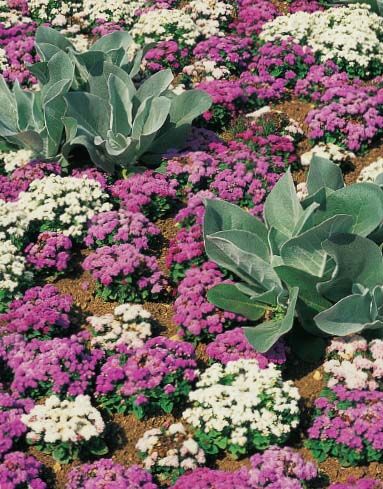
A stimulating composition in which colours and textures work well together. The velvet leaves of the verbascum find some sympathy with the fluffiness of the Ageratum flowers, but when their tall yellow flower spikes emerge, later in the year, the effect might be a little too startling!
Annuals such as poppies and cornflowers are frequently, mistakenly, planted in grass meadows where they are bound to be shortlived. However, a new concept in gardening is the notion of a small fragment of cornfield, even sown with barley or wheat, and where such annuals could be made to thrive. Management is simple: ‘harvest’ in late summer, removing straw and plant material after it has shed its seed; disturb the ground and wait for next year’s self sown crop to grow!
Paving and gravel
Even the most unsympathetic hard landscaping can often be persuaded to yield up a planting opportunity or two. Where space is limited and plants few, immense care is needed to select exactly the right ones, since each specimen will be making a large statement. This is like comparing a string trio, where a missed note on the violin jars the whole performance, with a huge orchestra and choir where, if a bass sings temporarily out of tune, only the sharpest ear will pick up the drone. Not only must the most suitable plants be selected, for such key roles, they must also stay in near perfect condition.
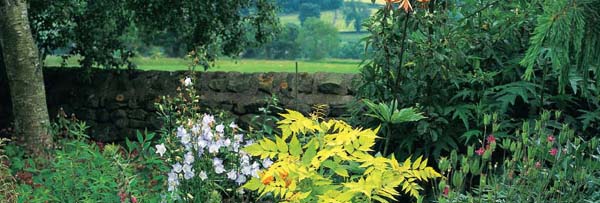
Borrowed landscape. The pastoral scene, behind the garden wall, makes a charming backdrop for more dramatic plant grouping in the foreground border.
Problem Site
Every planting site comes with its own special advantages and its own problems. It is important to assess both, in terms of plant choice. Disadvantages should not be viewed in negative terms, but should be recognised so that plant choice is limited to those species which will thrive in the prevailing conditions.
The main challenges to plants are caused by the following typical situations, either in isolation or – more usually – in combination:
Exposure to wind Plant robust trees and shrubs to windward, to create shelter. Hedges and shrub screens are more effective at wind protection than walls or solid fences which cause damaging eddy currents. Be prepared to plant for more extreme conditions, as your sheltering plants develop, and, as shelter becomes more available in the garden, adjust your planting plans to take advantage of the new conditions.
Excess shade Thinning out the overhead branches of mature trees often lets in more daylight. It may also help to paint any surfaces with white or a light colour. In moist shade, select plants from damp woodland habitats. Where trees are intended, as part of a planting scheme, select varieties such as Robinia, whose leaves are late emerging. The delay will enable spring plants under the branches to flower and begin to seed before light levels are reduced.
Excessively dry shade Moisture-retaining mulches will help, as will establishing a dense vegetative ground cover. Under trees, focus on plants that flower during winter and spring, when overhead branches are bare. Be content with a narrow choice of plants, but try any that you think might survive. All conditions differ, and plants that languish in one person’s dry shade, may perform well in another. Once you know the plants that will live, focus hard on these, selecting them in as many different forms as you can.
Excessively hot, sunny and dry Hardly a problem site! The number of plants that love such hot conditions is vast and varied, from desert succulents to winter and spring flowering bulbs. Count your blessings and get to love small bulbs, sedums, helianthemums, dwarf irises and so on.
Excessive wet – especially when caused by poor drainage Good drainage is essential for most plants to thrive. However, some wetland species are better at coping with poor drainage than others. Try to minimise the problems associated with bad drainage by installing raised beds, or following the advice given for excessively heavy soil below. Select wetland plants such as hostas, water iris, ligularias and Lobelia cardinalis.
Heavy or light soil Surprisingly, the same improving measures apply to both: dig in as much compost or leafmould as possible, building up the levels of organic matter. Heavy clays can be improved by digging in coarse grit, leaf mould or rotted compost. Light sand also benefits from a boost to its organic content and also needs a heavy mulch each summer, to assist with moisture retention.
Excessively alkaline (limy) or acid soil Limy soil can be made less alkaline by applying sulphur, but the effect is limited. Acid soil can be limed to bring the up the pH, but that effect is difficult to reverse. Of all problem sites, these two are the easiest to solve, simply by wise plant selection. If your soil is limy, learn to live without rhododendrons, but to revel in pinks, clematis and the thousands of species which love alkaline conditions. If your soil is acid, your azaleas, camellias, summer heathers and ravishing blue Himalayan poppies will be the envy of your friends.
Having an Open Mind
With so much at stake, it is far too easy to forget that we garden largely for pleasure – or if we don’t, we should! You can therefore be pretty relaxed about how you try out various planting combinations, and can afford to make mistakes. Plants and planting schemes are plastic, that is, they can be moulded or changed as you go. Only the boldest artist who dares to try something outrageous or at least, unprecedented, is likely to end up with a creation that is special.
New gardeners sometimes become so anxious about getting everything right that they forget to take pleasure in what they are doing. Experienced gardeners, however, are constantly learning. They make frequent mistakes and will enjoy a lifetime of adjusting, re-planting, devising new projects, trying out new plants and just generally messing about in their gardens. In fact the only serious, damaging and lasting mistake you can ever make, with your garden, is to think that you have finished.
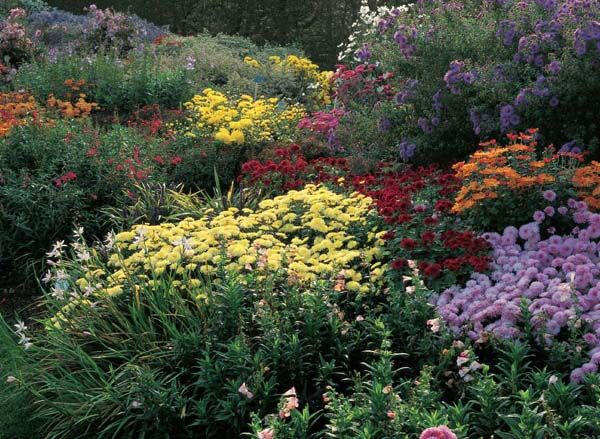
Flowers come in a rush, through spring and summer, and mid-winter plants are always sought-after. Too few of us, however, remember to plan for the ‘forgotten season’ – the autumn. This border of asters, chrysanthemums and other short-day flowers shows what superb colour autumn can bring.
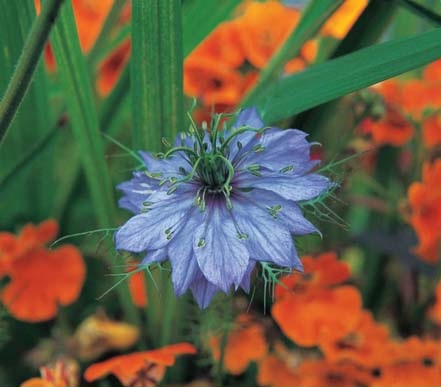
annuals
Annuals for exposed sites
Annuals for sheltered sites
Annuals for extra poor soil
Annuals for gap filling in mixed border
Annuals for exposed sites
Agrostemma githago
Corn Cockle Annual
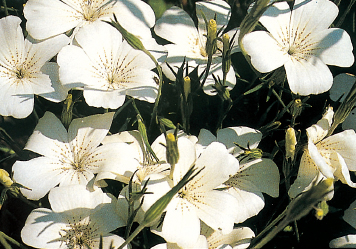
Cornfield annual with long, thin, somewhat lax stems, narrow, slightly hairy leaves and a long summer succession of large, rosy purple flowers, each with dotted lines leading to the centre. Support is necessary, either from other plants or with stakes or sticks. Selections include ‘Ocean Pearl’ – white with silver lines – and the pale ‘Pink Pearl’.
Soil preference: Any
Aspect: Full sun
Season of interest: Summer
Height and spread: 1m plus (3ft plus)
Companion plants: Excellent annual for the border back, especially if it can lean against shrubs or come up among perennials with better standing qualities. Also fine in a naturalistic annual border with other cornfield annuals such as cornflower and larkspur.
Adonis annua
Pheasant’s Eye Annual
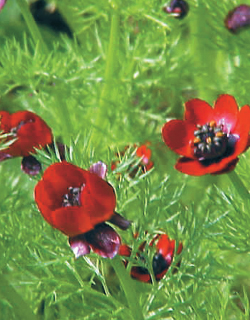
A cornfield annual with emerald green, feathery or filigree foliage on narrowly branched stems. From early summer, a succession of small, intensely blood red buttercup-like flowers nestle among the soft foliage, creating a strong contrast. Autumn sown plants grow larger and flower more profusely and for longer than those which germinate in spring.
Soil preference: Any, not too dry
Aspect: Sun, part shade
Season of interest: Summer
Height and spread: 45cm × 15cm (18in × 6in)
Companion plants: A wild species with modest beauty, but effective when dotted among perennials in a mixed border or growing in gravel where it will take over from such late spring bulbs as fritillaries or late tulips.
Malcolmia maritima
Virginian Stock Annual
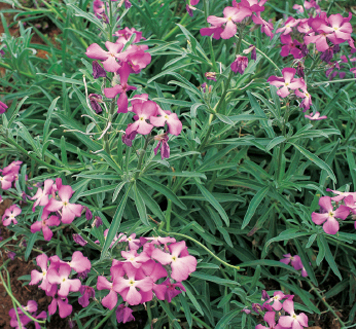
Almost every child’s first plant from seed, since it will flower a few weeks after sowing. Narrow foliage and slender stems produce a short but intense succession of brightly coloured, four-petalled flowers. Good seed series include flowers in shades of pink, white, cream, purple or near red, but these plants need to grow in bold drifts to create a strong effect.
Soil preference: Sandy, free-draining but not too dry
Aspect: Sun or part shade
Season of interest: Summer
Height and spread: 20cm × 10cm (8in × 4in)
Companion plants: Best sown in patches at a border front, with taller perennials behind, or among cottage garden flowers in an informal planting. These are often blended with night scented stock, Matthiola bicornis, for evening fragrance.
Papaver rhoeas ‘Shirley Series’
Shirley Poppy Annual

Garden World Images
Developed in the 19th Century by the rector of Shirley, Rev. Wilkes, from the showiest of cornfield weeds, this series has flowers ranging from lemon through pink to red, some with picotee edges in pale pink or white. The pollen is always golden, in contrast with wild field poppies, whose pollen is dark grey. More annual poppies on pages ref 1 and ref 2.
Soil preference: Any
Aspect: Sun
Season of interest: Summer
Height and spread: 30–60cm (1–2ft) × 20–40cm (10in–1ft 4in)
Companion plants: Other annual poppies work beautifully with Shirley seedlings, especially if allowed to naturalize in a gravel garden or sown at random in an annual border with such annuals as marigolds, clarkias, larkspurs and cornflowers.
Nigella damascena
Love-in-a-mist Annual
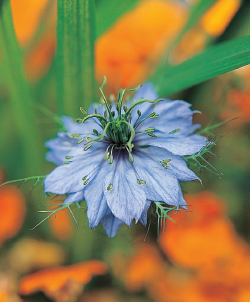
Lacy, filamentous foliage makes a soft and alluring background for the flowers, whose distinctive blue petals nestle among the feathery leaves. Garden series such as ‘Persian Jewels’ have purple and white flowers, as well as those in various shades of blue. The large, inflated, lantern-like seed capsules are almost as decorative as the flowers and last until autumn.
Soil preference: Any
Aspect: Sun or part shade
Season of interest: Summer, autumn
Height and spread: 30–45cm (1ft–1ft 6in) tall
Companion plants: A lovely annual to naturalize among roses, especially the older varieties. Also effective for gap-filling, in a mixed border or for lining a lavender hedge.
Lagurus ovatus
Hare’s Tail Grass Annual grass
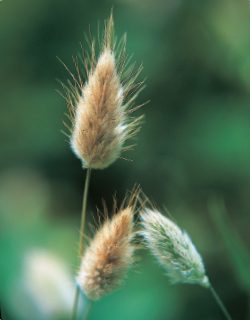
Mediterranean species with grassy foliage and silvery grey flowers which are broadly oval and furry to the touch, resembling the tail of a hare or rabbit. This grass grows taller on rich soil but thrives as a smaller plant in harsh conditions. A dwarf form, ‘Nanus’, may be more suitable for gardens with rich soil.
Soil preference: Any free-draining
Aspect: Sun
Season of interest: Summer, autumn
Height and spread: 15–50cm (6in–1ft 8in) × 30cm (12in)
Companion plants: A worthy addition to a grass border, especially if planted with other annual grasses such as Briza maxima, but also lovely among flowering annuals. Scatter seed among pot marigolds, cornflowers or tagetes.
Annuals for sheltered sites
Anagallis monellii
Shrubby Pimpernel Perennial grown as a tender annual

A low, straggly plant with semi-trailing stems and small, triangular leaves grouped in threes along the stem. At each leaf joint, buds form which open as conspicuous, five-petalled flowers in the deepest, most intense blue. Similar, but larger in all its parts, to the wild blue pimpernel, Anagallis foemina.
Soil preference: Fertile, well-drained
Aspect: Sun
Season of interest: Summer
Height and spread: 20cm × 30cm (8in × 12in)
Companion plants: An excellent hanging basket or container plant which is especially effective when contrasted with bright yellow Bidens ferulifolia or harmonized with variegated trailing Plectranthus or with red pelargoniums.
Cerinthe major ‘Purpurascens’
Honeywort Annual

Cornfield annual from the Mediterranean with curious, glaucous foliage and, in early summer, metallic purple bracts which are remarkably luminous and which half conceal the strange brownish purple and yellow tubular flowers. The seeds are large and stone-hard. Although when established it will self-sow, the species is not hardy in sustained frost.
Soil preference: Any well-drained
Aspect: Sun
Season of interest: Summer
Height and spread: 50cm × 30cm (1ft 8in × 12in)
Companion plants: A distinctive plant for a Mediterranean garden among grey and silver-leaved herbs such as lavenders, Teucrium and sages. Excellent in gravel, too, among brown sedges such as Carex buchananii and also with Californian poppies.
Brachyscome hybrids
Swan River Daisy Annuals

The narrow, fresh, often lacy green leaves on these Australian native plants are almost hidden behind a generous covering of bright daisy flowers, in mauve, pink or white. A neat, but semi-trailing habit, coupled with summer-long flowering makes them ideal for container use. Good varieties include ‘Blue Haze’, the lilac coloured ‘City Lights’ and the purple-blue ‘Toucan Tango’. Tender.
Soil preference: Any, reasonably fertile
Aspect: Best in full sun
Season of interest: Summer
Height and spread: 45cm × 45cm (18in × 18in)
Companion plants: Yellow-flowered Bidens ferulifolia makes a good contrast, but the silver filigree leaves of Artemisia ‘Lambrook Silver’ or ‘Powis Castle’ also blend pleasingly.
Convolvulus tricolor
Annual

A non-climbing, but somewhat lax plant with small, oval leaves and saucer shaped flowers, similar to those of morning glories, but 5cm (2in) wide. The typical species has dark, royal blue petals, fading white or creamy yellow at the throat. Selected varieties include ‘Ensign Mixed’, with pink, maroon, blue and white shades, and the pale ‘Light Blue Flash’.
Soil preference: Any
Aspect: Sun
Season of interest: Summer
Height and spread: 50cm × 30cm (1ft 8in × 1ft)
Companion plants: Great for a mixed annual border or to dot in among such perennials as Mexican salvias, osteospermums or grasses.
Lavatera trimestris
Annual
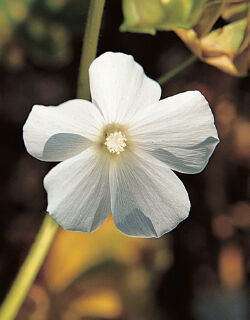
Tall, bold, with thick, rigid stems and large, slightly hoary leaves, this native of the Mediterranean regions has large, saucer shaped flowers whose stamens and stigma fuse to form a central spike. Colours range from rich pink, in ‘Silver Cup’ and ‘Ruby Regis’, to a startling white in ‘Mont Blanc’. Each petal is veined with darker lines.
Soil preference: Well-drained, fertile
Aspect: Sun
Season of interest: Summer
Height and spread: 60–90cm × 45cm (2–3ft × 18in)
Companion plants: Careful siting is necessary, with so conspicuous a plant. Excellent in bold groups on its own or among such large perennials as Galega, leucanthemums and Phlox paniculata, with perennial asters to follow.
Galactites tomentosa
Annual

A thistle with spiky, divided white and green foliage, which emerges in autumn or early spring, forming an attractive rosette. In summer, the stem lengthens and branches, eventually bearing lilac-mauve, tufted thistle flowers. Seed is borne on thistledown. This native of the Canary islands and Mediterranean self-seeds freely, but young seedlings will not survive prolonged frost.
Soil preference: Any free-draining
Aspect: Sun
Season of interest: Spring, summer
Height and spread: 1m × 75cm (3ft 4in × 2ft 6in)
Companion plants: Attractive when allowed to colonize areas between shrubs – especially such Mediterranean species as rosemary, lavender, Santolina or Phlomis fruticosa, or to pop up at random in a mixed border.
Annuals for extra poor soil
Briza maxima
Greater Quaking Grass Annual
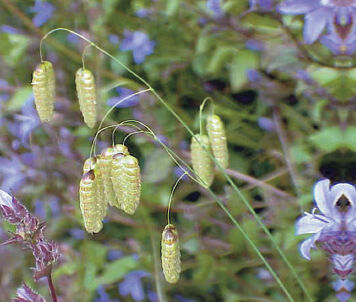
A free-seeding annual grass which performs best in hot, dry conditions, where the plants are less likely to become invasive. Mid-green, soft grass foliage emerges in autumn or spring. The flower stems are wiry and much branched, bearing cone-shaped flowers which shimmer and tremble in the slightest breeze. Superb for cutting and drying.
Soil preference: Dry, not too fertile
Aspect: Sun or part shade
Season of interest: Summer
Height and spread: 60cm × 45cm (2ft × 18in)

